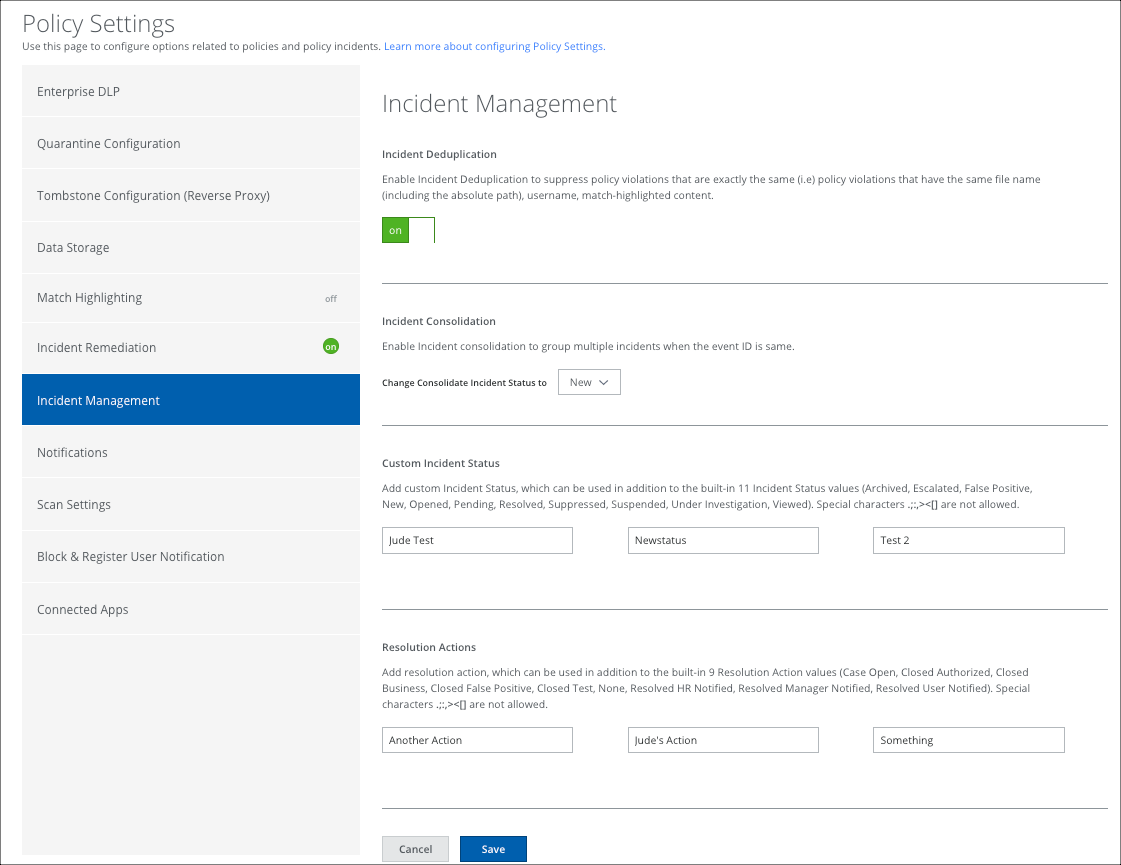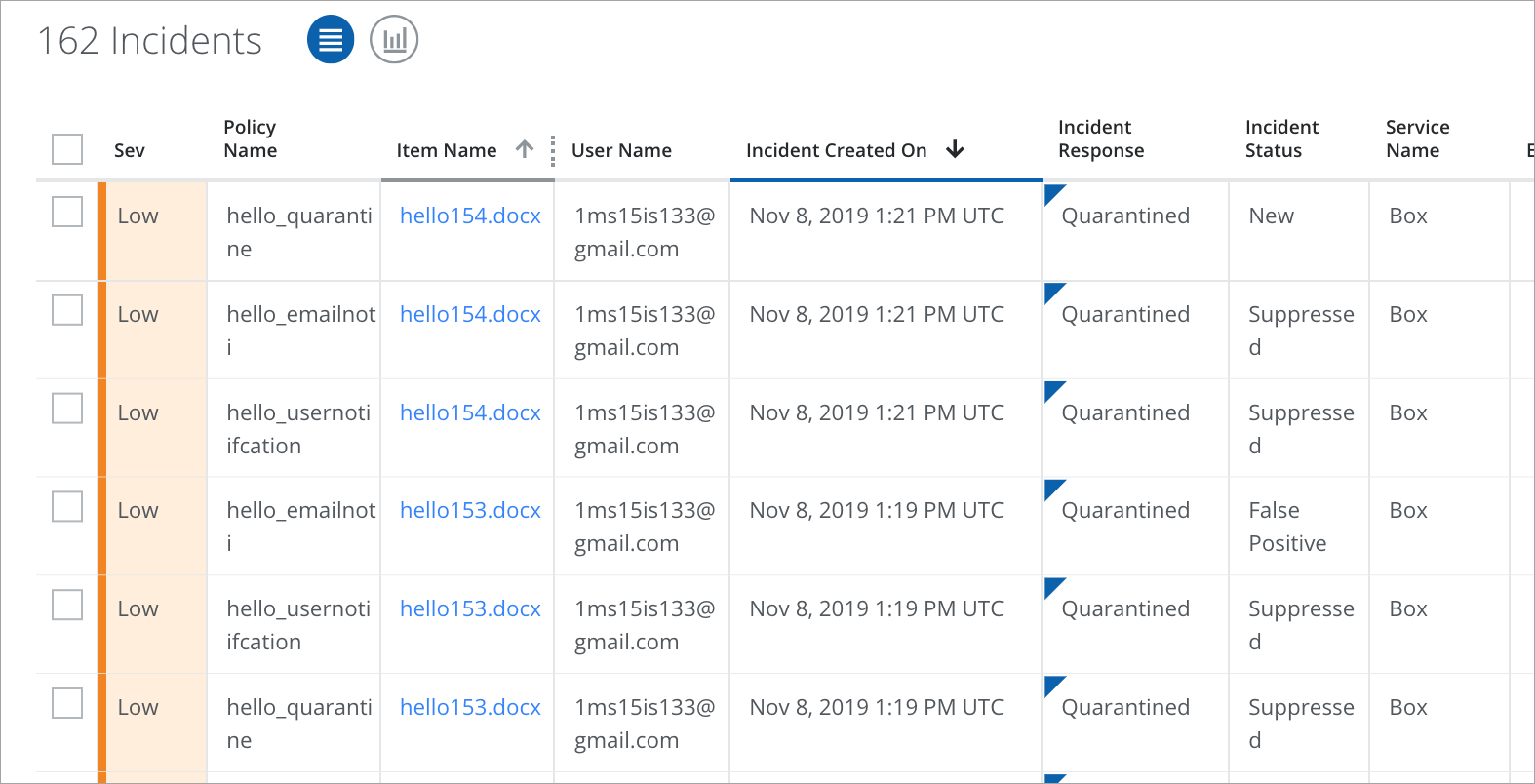Enable Incident Management
The Incident Management page allows you to customize the options related to policies and policy incidents and with this page, you can:
- Select Policy Incident View. Customize the display of incidents and set it as the default view on the Policy Incidents page by selecting a preferred view.
- Enable Potential False Positives. Enable to automatically detect policy incidents that may be false positives by analyzing patterns from previous false positives.
- Incident Deduplication. Enable Incident Deduplication to suppress identical policy violations (e.g., those with the same file name)
- Incident Consolidation. Enable Incident Consolidation to group multiple incidents with the same event ID.
- Custom Incident Status. Define the customized incident status values in addition to Skyhigh's built-in incident status values on the Policy Incidents cloud card.
- Resolution Actions. Define the customized resolution actions in addition to Skyhigh’s built-in resolution actions available on the Policy Incidents cloud card.
Select a Default View for Policy Incidents
You can select a default view to display the preferred sanctioned DLP policy incidents on the Policy Incidents page. The preferred view is displayed each time you log in and open your Policy Incidents page. The default view enables you to gain actionable insights into relevant policy incidents and perform additional forensics on the generated incidents.
It allows you to monitor and manage policy violations quickly and efficiently. Organizations can use the default view to enhance user experience, improve their data protection strategy, and streamline operational efficiency in incident management.
Set the Default View
You can set a default view for the Policy Incidents page in two ways:
- Policy Settings. On the Policy Settings > Incident Management tab, select the default view options as Focused View, Skyhigh recommended view, or Last used view. (OR)
- Policy Incidents. On the Policy Incidents > Views tab, click Default View Settings which redirects you to the Policy Settings page, where you can choose the required default view options.
Set Default View to Review Preferred Incidents
Select a preferred view to display incidents on the Policy Incidents page.
- Go to Policy > Policy Settings.
- Select the Incident Management tab.

- Under Select Policy Incident view, select any one of the following saved views:
- Focused View (Skyhigh). Highlights new and open incidents on the Policy Incidents page, enabling you to concentrate on high-priority issues that demand immediate attention.
- Load my Saved Views. Displays incidents based on the selected Saved View on the Policy Incidents page, ensuring you are presented with the most relevant incidents for effective monitoring and management. You can select the required Skyhigh predefined Saved View from the menu.
- Remember my last view. Displays incidents by remembering your last used view on the Policy Incidents page, providing a seamless experience that saves your time and effort.
- Click Save.
You can now view incidents that are sorted based on the default view on the Policy Incidents page.
Detect and Reduce ML-Driven Potential False Positives
|
Limited Availability: To access ML-driven Potential False Positives (an advanced DLP capability) requires additional entitlement. Contact Skyhigh Support or your account manager for assistance. |
You can enable ML-driven Potential false positives to automatically detect and classify sanctioned DLP incidents that may be false positives on the Policy Incidents page. It utilizes a machine learning-based statistical model that employs unsupervised learning techniques to identify patterns derived from the management of previous false positive DLP alerts by SOC analysts. This approach enables you to efficiently monitor and manage false policy violations with greater speed and ease.
Organizations can leverage Potential False Positives to improve operational efficiency, reduce alert fatigue, and enhance the overall accuracy of their DLP policies. It allows you to streamline incident management by reducing the time spent reviewing false positive incidents and focusing on real threats. For details, see About ML-driven Potential False Positives.
To enable ML-driven potential false positive detection:
- Go to Policy > Policy Settings.
- Select the Incident Management tab.

- Toggle Enable Potential False Positives to On.
- You can view the statistics and search for potential false positive incidents on the Policy Incidents page. For details, see About Policy Incidents.
NOTES:
- Initial Setup of New User. New users may notice that the initial count of potential false positives on the Policy Incidents page shows 0. This is because the toggle for tracking false positives has not been activated yet. As new potential false positives are detected, they will be tracked and displayed accordingly.
- Existing User. If you are an existing user and the toggle button is disabled, you can view past counts of potential false positives that occurred within the last 30 days on the Policy Incidents page. However, new counts will only appear once the toggle is re-enabled.
For example, if you disabled the toggle last week when there were 10 potential false positives, those 10 will still be visible in the 30-day history. Once re-enabled, the count will update with any new potential false positives detected.
Enable Incident Deduplication
Policy Incident Management (Deduplication) updates newer DLP policy violations automatically by adding the "Suppressed" status when the file name (including the absolute path), the username, and the offending content is the same. This prevents new policy violations from being displayed by default, no matter how many times the file is updated or modified, while the actual offending content is still the same.
Deduplication works by checking violations to see if they are similar, which means that the filename with the absolute path, username, and offending content is the same for a newer violation. When a similar violation is created, it is automatically marked as Suppressed, and effectively de-duplicated.
Deduplication applies even if the offending content is reordered within the document. For example, if the user changes the order of credit card numbers in a document, or if the text before or after the offending matched content is changed, no new violation is displayed.
IMPORTANT:
- If the status of an incident is changed to "Resolved", its deduplication status is reset. A future violation of the policy on the same file and offending content will create a new incident with the status "New" instead of "Suppressed".
- Deduplication is only applicable to content-based rules.
By default, Incident Deduplication is enabled in your tenant. You can disable this feature on the Policy Settings page, or later re-enable it.
To enable Incident Deduplication:
- Go to Policy > Policy Settings.
- Select the Incident Management tab.

- Toggle Incident Deduplication to ON.
- Click Save.
Enable Incident Consolidation and Custom Incident Status
The Incident Consolidation allows you to group multiple incidents that have the same event ID in the DLP Policy. You can also create Custom Incident Statuses to group incidents.
To enable Incident Consolidation:
- Go to Policy > Policy Settings.
- Select the Incident Management tab.
- Select the status from Change Consolidate Incident Status to. For more details, see DLP Policy Incident Statuses.
- Add one or more Custom Incident Status. To create additional status, click +.
- Click Save.
- You are redirected to the Policy Incidents page. You can view the various Incident Status depending on the primary and secondary policy incidents.

About Primary and Secondary Policy Incidents
If an event, message, or uploaded document violates more than one policy, an incident is created for each corresponding policy, and actions are taken to the most restrictive policy. The restrictive policy is considered the Primary Policy, and the other policies as Secondary. The Primary Policy incidents are identified by the highest precedence order over the response action. For more details, refer to DLP Policy Response Action.
For example, consider the uploaded file violates three policies: Policy A, Policy B, and Policy C. The incidents are created for three different policies, and these policies lead to three different response actions such as Policy A – Quarantine, Policy B – Email Notification, Policy C – User Email Notification.
Here, Policy A is considered the Primary Policy incident, because it's the most restrictive policy and has the highest precedence order for the response action (Quarantine).
Policy B and Policy C are considered Secondary Policy incidents.
Incident Status Precedence
Here's how the Incident Status takes precedence when DLP incidents are created, depending on the method used:
- Incident Deduplication. The first priority is Incident Deduplication. When a duplicate incident is marked as Suppressed, then the status is set to Suppressed.
- DLP Policy Wizard. The next priority is any incident status automatically set in a DLP policy using the DLP Policy Wizard.
- Incident Consolidation. The last priority is the Incident Consolidation status, used to group multiple incidents when the event ID is the same.
IMPORTANT: Due to the priority order, it is not supported to use the DLP Policy Wizard to automatically set the incident status and Incident Consolidation at the same time. Use one feature or the other.
Impact of Incident Deduplication and Incident Consolidation on Incident Status
- The incident status New is assigned only for Primary Policy incidents that have no deduplication.
- The incident status Suppressed is assigned for Primary or Secondary policy incidents that have been found to be a duplicate of a previously generated policy.
For example, consider Incident A as the Primary incident. Incident B and Incident C are secondary incidents that have the existing consolidation status Resolved and False Positive.
- Incident Status for Incident A is considered New since it’s the Primary Policy incident with no deduplication.
- Incident Status for Incident B and Incident C are considered Suppressed. Incident B and C are duplicates of a previous policy, and hence the existing statuses Resolved and False Positive are overridden by the Suppressed status.
- If the status of an incident is changed to Resolved, its deduplication status is reset. A future violation of the policy on the same file and offending content will create a new incident with the status New instead of Suppressed.
Add Resolution Actions
You can define custom Resolution Actions to be used with Incidents. Assign the Resolution Action on the Incidents > Policy Incidents > Incident Details page.
- Go to Policy > Policy Settings.
- Select the Incident Management tab.
- Define a custom Resolution Action for Incidents. Click + to assign more.
- Click Save.
Limitations
- Incident Management does not apply to Fingerprints.
- Incident Management cannot be used for incidents received through Enterprise DLP integration.
